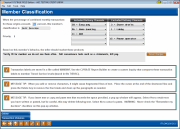Editing/Adding a Transaction Label
|
Screen ID: Screen Title: Panel Number: |
UMCLAS-02 Member Classification 2442 |
|
Access this screen by selecting a label choosing the Select option or by selecting Add (F6) from the Configuring Transaction Label screen.
On the left side of the top of this screen you can choose up to 5 different delivery channels (origin codes) to be included in the transaction counts.
On the right side of the top of this screen you can choose to exclude up to 5 origin codes from the calculation. This is primarily so that you can omit transactions share drafts from the calculation. Otherwise every member would show up with an activity branch based on their share draft activity only (since that is usually the heaviest volume). See below for more details on this calculation.
At the bottom of the screen are free-form text fields into which you can type any marketing tips, instructions, “scripts,” or other information to help your staff interact appropriately with these members. These comments will appear on the Transaction Activity window.
Tips on entering text in this text box.
-
Use Transaction Volumes (F9) to display the Transaction Count by Delivery Channel screen. This can assist in deciding which transactions types are heaviest and therefore might need to be included or excluded from this label calculation.
When done, use Enter to save, then use the Backup button (F3) to return to the initial screen.
Calculating Transaction Percentages
Activity is calculated using the following formula:
A = Add all transactions with “included” origin codes
B = All transactions (all origins) minus “excluded” origin codes
(A ¸ B) × 100 = % for label
Example:
Susan A. Member had the following transaction activity during a month:
|
Origin |
# of Trans |
|
01 Lobby/Teller |
6 |
|
02 Share drafts |
17 |
|
04 Direct post |
1 |
|
07 Journal transfers |
2 |
|
11 ACH |
4 |
|
15 Phone |
2 |
|
Total transactions |
32 |
The Employee/Direct label is configured to include origin codes 01, 04, 07, and 15 (shown shaded above). If over 50% of a member’s transactions fall into these types, the member would be considered an “Employee/Direct” member. The following charts show the way this member’s label would be calculated, both with the share draft (origin 02) exclusion and without it, for comparison purposes.
Excluding share drafts from the calculation:
|
Included transactions |
11 |
A |
(A / B) × 100 = % (11 / 15) × 100 = 73.3% |
|
Total transactions |
32 |
|
|
|
Excluded (origin 02) |
-17 |
|
|
|
Analyzed (Total trx minus excluded trx) |
15 |
B |
· With this configuration, the member would be assigned an Employee/Direct label.
Without excluding share drafts:
|
Included transactions |
11 |
A |
(A / B) × 100 = % (11 / 32) × 100 = 34.4% |
|
Total transactions |
32 |
|
|
|
Excluded (origin 02) |
-0 |
|
|
|
Analyzed (Total trx minus excluded trx) |
32 |
B |
· With this configuration, the member would NOT be assigned an Employee/ Direct label.
As you can see, excluding share drafts from the calculation allows a much more realistic evaluation of the member’s behavior patterns.
·CU* TIP: Transaction labels are stored in a file called MAMBINF. Use the Report Builder to create a custom inquiry that compares these transaction labels to member Tiered Service levels (stored in file TIERSC).
Button
|
Button |
Description |
|
Transaction Volumes (F9) |
View and inquiry screen showing transaction count by delivery channel. This can assist in deciding which transactions types are heaviest and therefore might need to be included or excluded from this label calculation. |
SEE ALSO: Knowing Your Members CU*BASE Relationship Management Tools
